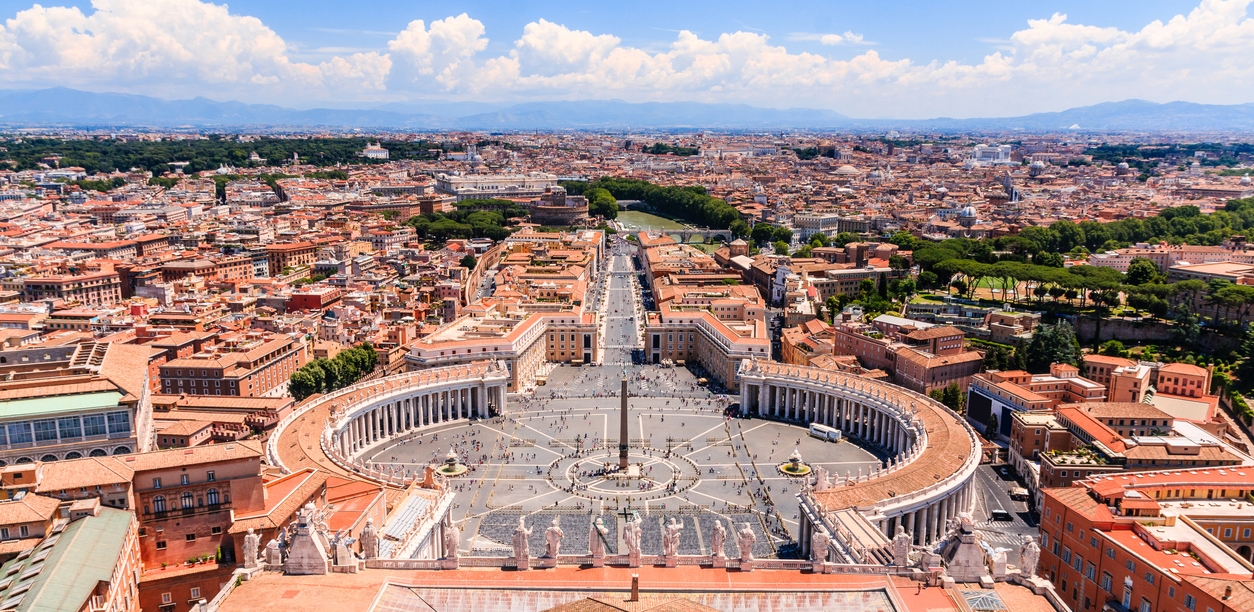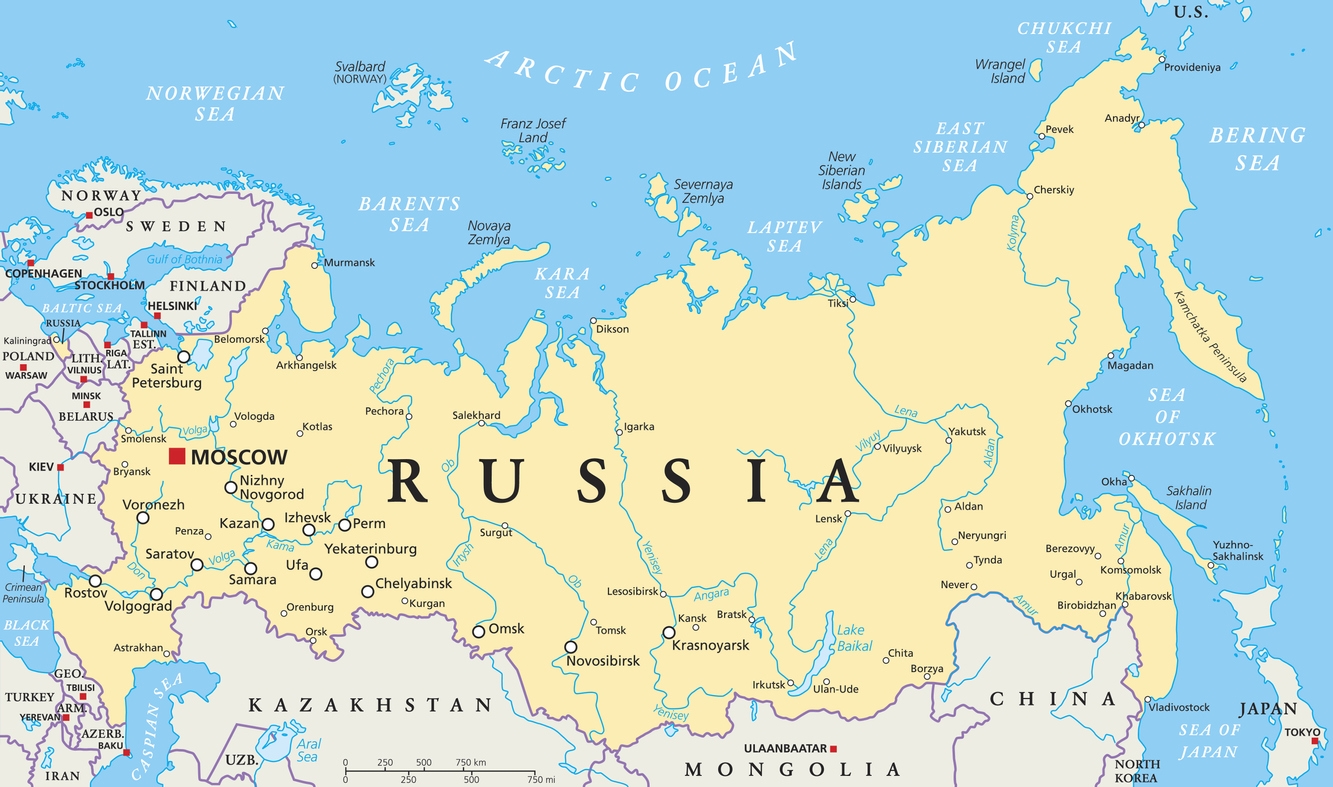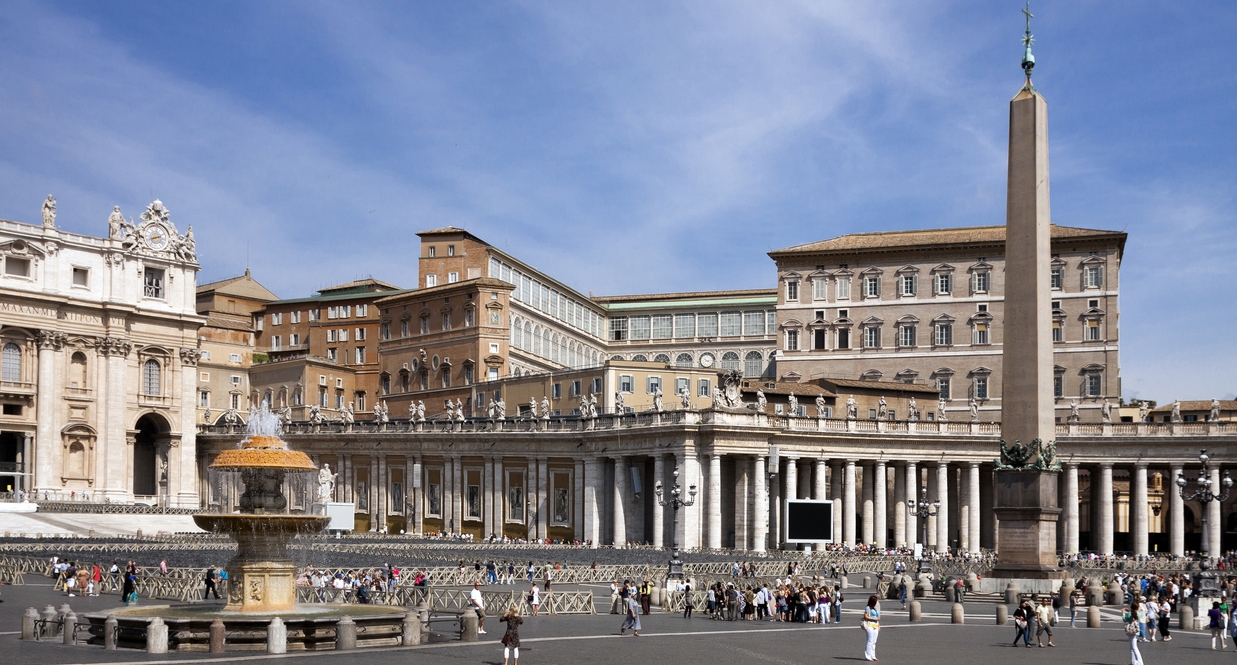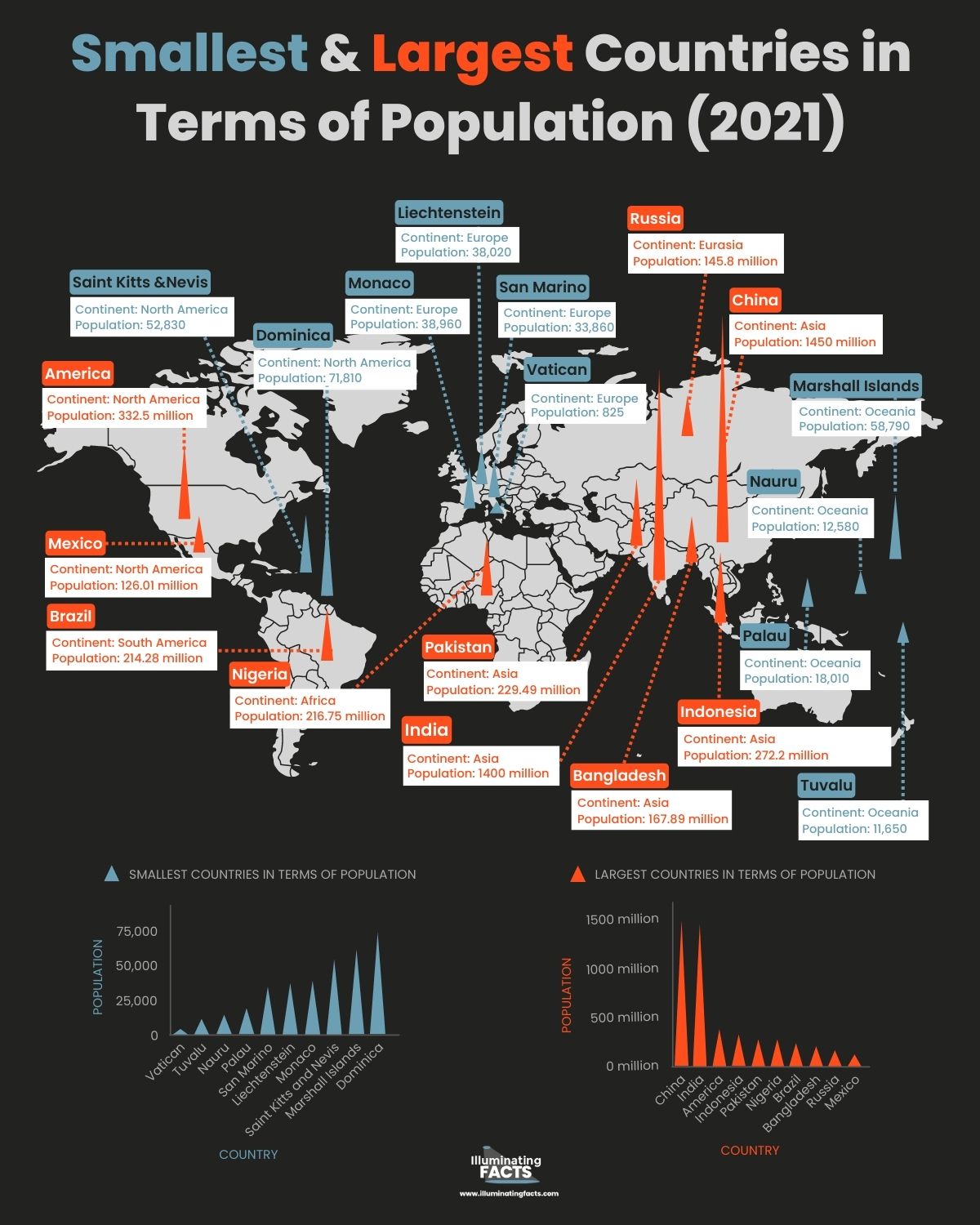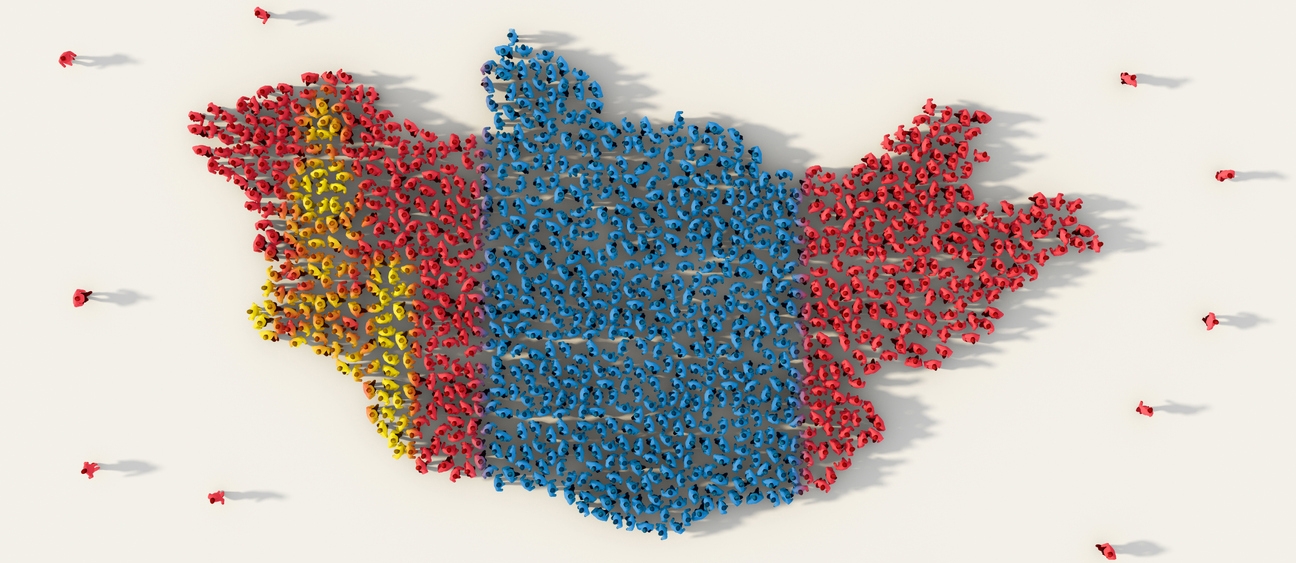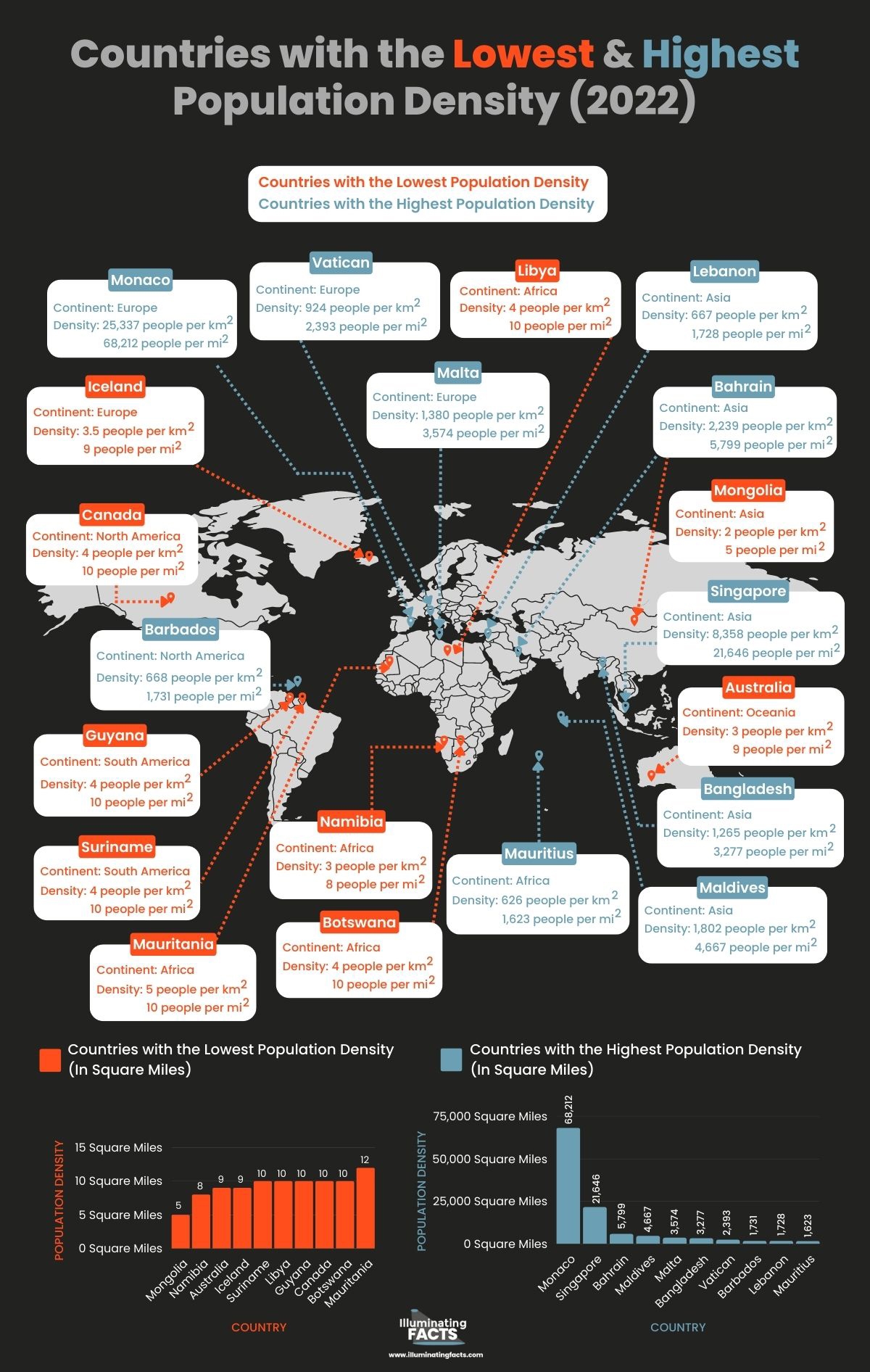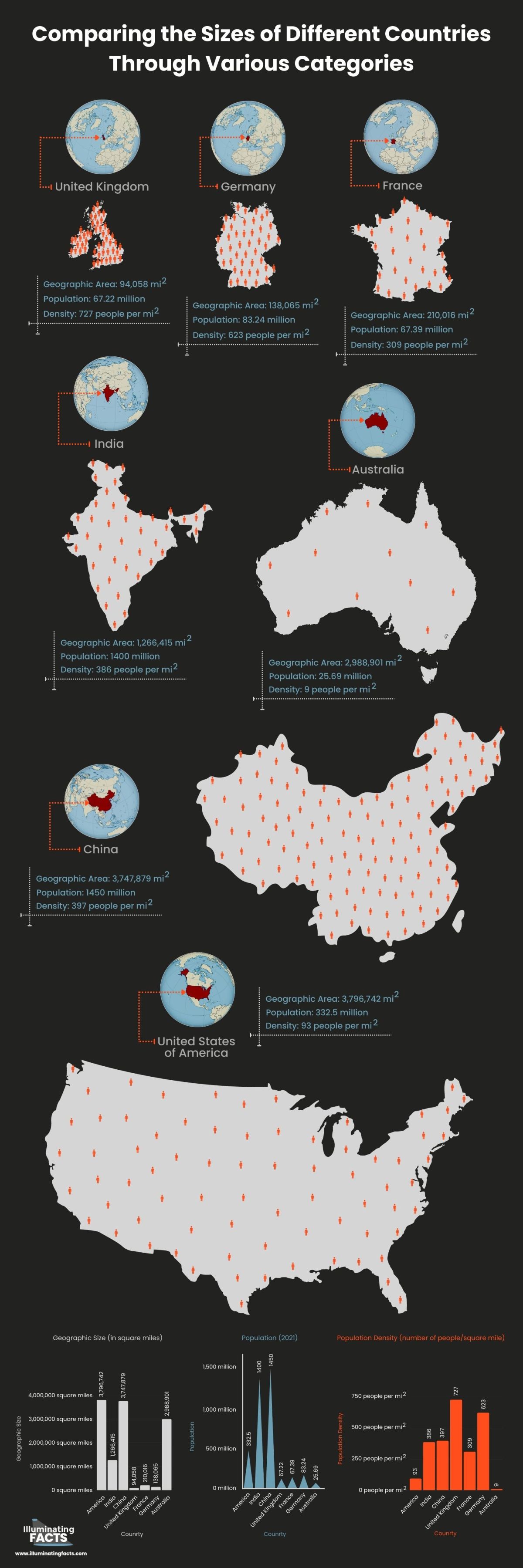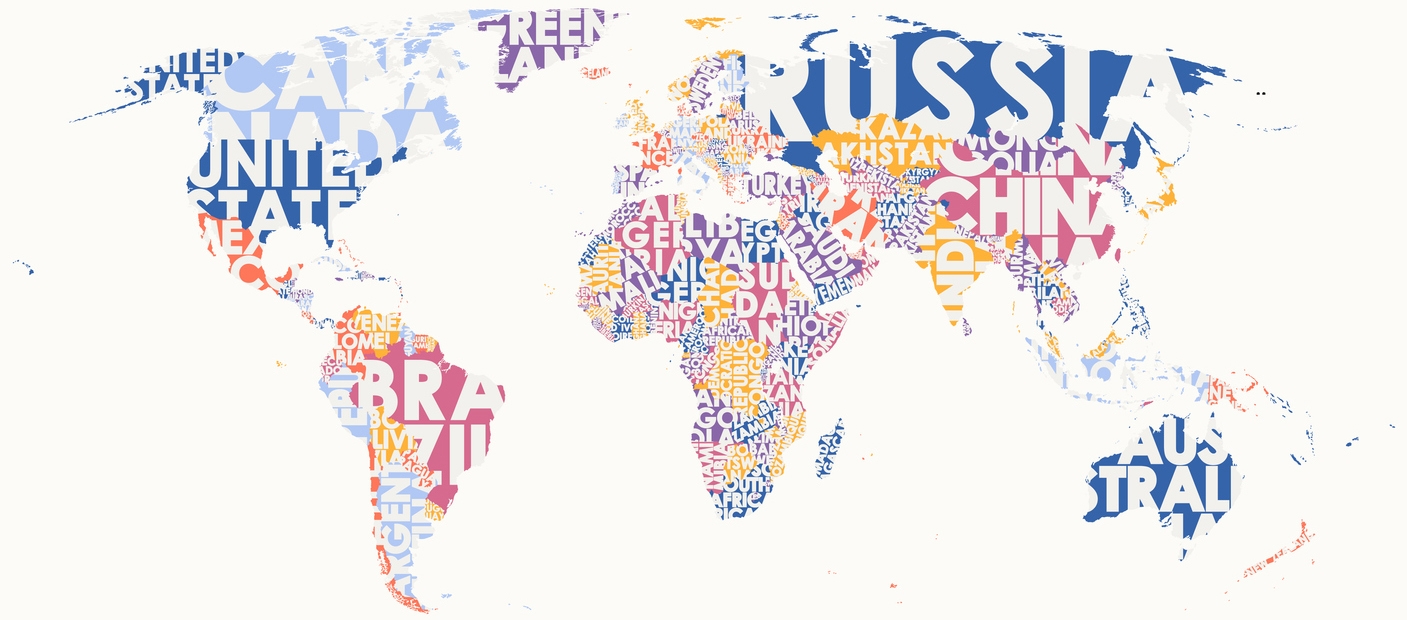Background
Our world is made up of continents, and each continent is made up of different countries. The countries in the world can be compared in various aspects, such as culture, language, weather, and size. In this post, we are going to focus on discussing the size of countries. When we talk about the size of countries, it does not only refer to how big it is physically. There are also other characteristics that we can look into, such as its population, population density, and geographic size.
What do you think makes a country huge or small? Borders define nations, and the political and possibly natural limits of a country determine its physical territory, thus, its size. Natural borders pertain to rivers, seas, oceans, and mountain ranges, while political boundaries refer to the artificial lines that separate one political entity, such as a state or country, from another. If you want to learn more about this, read on as we are going to give you more information about visualizing the size of countries.
Countries with the Smallest Geographic Sizes
National borders may be mere human constructs, but they are very powerful. It is easy to see countries with the largest landmasses and seemingly endless borders, such as the United States, Canada, Russia, and so on. It’s because these countries often have vast resources and sheer size. But aside from the largest countries, many of the smallest countries in the world are also very powerful. [1]
What is the Country with the Smallest Geographic Size?
The Vatican
It can be tough to imagine, but there is a country on the globe that is smaller than New York City’s Central Park. If we are going to base it on the landmass, the smallest country in the world is Vatican City, which measures only 0.2 square miles. It is almost 120 times smaller compared to the island of Manhattan.
The Vatican is also referred to as a city-state. It has the distinction of being the global headquarters of the Roman Catholic Church. It is located in the middle of Rome, Italy. It is a historic enclave that is home to the Holy See, which is another term for the government of the Roman Catholic Church. The head of its administration is the Pope, and his authority extends over all Catholics in the world. [2]
If you want to imagine how small the Vatican really is, it actually occupies less than a square mile. It is so small that it covers only 49 hectares. But it is an independent country that has its own post office, telephone system, banking system, and radio station, among other signs of nationhood. The currency in this country is called the Vatican Euro, which is being accepted throughout the Eurozone. [3]
Countries with the Smallest Geographic Area |
||
| Country | Continent | Geographic Area (in square miles) |
| Vatican | Europe | 0.2 square miles |
| Monaco | Europe | 0.78 square miles |
| Nauru | Oceania | 12 square miles |
| Tuvalu | Oceania | 10.04 square miles |
| San Marino | Europe | 23.63 square miles |
| Liechtenstein | Europe | 60 square miles |
| Marshall Islands | Oceania | 70 square miles |
| Saint Kitts and Nevis | North America | 104 square miles |
| Maldives | Asia | 114 square miles |
| Malta | Europe | 122 square miles |
Other Countries with the Smallest Geographical Sizes
In addition to the Vatican, below are the other countries that are the smallest when it comes to the area they cover:
Monaco
On the French Riviera, Monaco is a sovereign principality that borders the Mediterranean Sea. By land, Monaco is surrounded by France, while the Mediterranean is on its eastern coast. This country is known as a tax haven for the very rich. Geographically, it occupies less than a square mile, covering only 202 hectares.
The main industry of Monaco is tourism. Many people visit the country to gamble in the famous casinos, enjoy the luxurious beaches, go boating, and watch car racing events, such as the Grand Prix de Monaco. In addition to those, it is also home to strong banking, finance sectors, and real estate. The country is ruled by Prince Albert Alexandre Louis Pierre Grimaldi, also known as Prince Albert II, whose family has ruled the country on and off since the late 1200s. [3]
Nauru
Nauru is a raised coral island located in the southwestern Pacific Ocean, just 25 miles south of the equator. It occupies only about 12 square miles or 20 square kilometers. It is often considered among the highly westernized islands of the South Pacific. Because of the arrival of missionaries on the island in the late 1800s, around four in five Nauru residents identify as Christians.
Phosphate mining dominated Nauru’s economy for most of the 20th century, with Britain, New Zealand, and Australia controlling the sector there. Almost all of the manufactured items, food, and even water on Nauru are imported from Australia. [3]
Tuvalu
This country is referred to as the sinking country. Tuvalu is made up of a small archipelago of coral islands in the west-central Pacific Ocean, covering about 420 miles from northwest to southeast. It only has 10.04 square miles of land. Rising ocean levels are gradually covering its land. This is due to global warming, increasing water levels, and due to the country’s dying coral. Its coastlines are also eroding into the sea.
According to scientists, it is predicted that the island country of Tuvalu could become inhabitable in the next 50 to 100 years. It also can no longer sustain itself through crops grown on its land due to drought as the heat intensifies. This is why the majority of its population is migrating to nearby countries like New Zealand. [3]
San Marino
San Marino is a landlocked republic in the middle of Italy that is only 23.63 square miles in size. Its official language is Italian, and most of the people living in this country are Roman Catholics. Agriculture and tourism are both important to San Marino as it is largely urban. What’s amazing is that San Marino dates back to before the Renaissance, being a reminder of the self-governing city-states of Italy. It also started as a settlement for Christians escaping persecution from Rome. [3]
Liechtenstein
Liechtenstein is a country between Switzerland and Austria. It covers around 60 square miles of land. This small country is characterized by the Alps, and it is headed by a constitutional monarchy. The leading part of the economy of Liechtenstein is tourism, which is sponsored by the government, along with foreign banking. [3]
Marshall Islands
The Marshall Islands is a small island country that takes up only 70 square miles of land. It is made up of over 1,000 islands that are home to over 58,000 people. This country, along with its security and defense, is supported by the United States. The territory is used as a military base and missile test range. However, like Tuvalu, it is also sinking into the sea. [3]
Saint Kitts and Nevis
Saint Kitts and Nevis is a tiny country found in the eastern Caribbean Sea. It is a tropical paradise that covers only 104 square miles of land, and it is spread over two islands. The country is surrounded by coral reefs, and most residents are of African ancestry. The driving force of the country’s economy is tourism, but before, the sugarcane industry was dominant. Both the British and French have ruled this country at various points in history. Today, it is an independent country and a member of the Commonwealth. [3]
Maldives
The Maldives is a popular tropical destination for tourists, and it is among the smallest countries in the world in terms of land size. It occupies only 114 square miles of land. It features 26 atolls and more than 1,100 islands. It is popular for its incredible resorts, urban landscapes, and snorkeling. It is found in the Indian Ocean between Africa and Indonesia. It is also the lowest-lying country in the world, which is just about four feet above sea level. [3]
Malta
Malta, which only has 122 square miles of territory, is the tenth-smallest nation in the world. It is found in the central Mediterranean Sea. It is an island country governed by everyone from the Greeks and Romans to the Arabs, Sicilians, British, French, and more. It was in 2004 when it was admitted to the European Union. Today what form its varied economy are tourism, agriculture, shipbuilding and repair, fishing, finance, and manufacturing. [3]
Countries With the Largest Geographic Sizes
After learning about the smallest countries in the world, let us move on to the largest countries in terms of land size or area. The countries of the world that are diverse in terms of language, wealth, and culture are also very diverse in terms of size. While the smallest countries measure just a few square miles, the largest ones are absolutely massive. [4]
What is the Country with the Largest Geographic Size?
Russia
In terms of land size or area, the largest country in the world is Russia, with a total area of 6,601,665 square miles and a land area of 6,323,142 square miles. Its size is equivalent to 11% of the total landmass of the world, which is 57,510,000 square miles. [5] In fact, if it were to lop off 2 million square miles, it would still be the largest, and the lopped-off section would rank seventh overall.
Russia is a transcontinental country that stretches from Asia to Europe. It borders 16 countries and has 11 different time zones. The Kievan Rus of the ninth century, which grew under the control of the Viking chieftain Rurik, is where Russia’s history begins. A notable expansion of territory occurred in the late 16th century under the rule of Ivan the Terrible, who was the first official tsar of Russia.
The country became the third-biggest empire in the world by the early 18th century. It constituted the largest part of the Soviet Union when the latter was established. After the fall of the Soviet Union on December 25, 1991, the Russian Federation, or Russia as we know it today, was born. [6]
Countries with the Largest Geographic Area |
||
| Country | Continent | Geographic Area (in square miles) |
| Russia | Eurasia | 6,601,665 square miles |
| Canada | North America | 3,855,100 square miles |
| United States of America | North America | 3,796,742 square miles |
| China | Asia | 3,747,879 square miles |
| Brazil | South America | 3,287,957 square miles |
| Australia | Oceania | 2,988,901 square miles |
| India | Asia | 1,266,415 square miles |
| Argentina | South America | 1,074,000 square miles |
| Kazakhstan | Eurasia | 1,050,000 square miles |
| Algeria | Africa | 918,923 square miles |
Other Countries with the Largest Geographical Sizes
Next to Russia, here are the other countries with the biggest geographical sizes:
Canada
The second biggest country in the world in terms of land size is Canada. It covers an area of 3,855,100 square miles, making it the largest country in the western hemisphere and in North America. Did you know that the United Kingdom can fit into Canada 40 times? Yes, that is how big it is. However, it also hosts about 50% of the world’s natural lakes. Therefore, if the water area of the lakes is left out, Canada is smaller than the United States by land size alone.
In addition to being the second biggest country in the world, Canada also has the longest coastline at 125,567 miles. It is bordered by three oceans, which are the Atlantic, Pacific, and Arctic. It borders the United States to the south for around 5,592 miles. [6]
United States of America
The third-largest country in the world in terms of geographical size is the United States. It has a total area of 3,796,742 square miles. The connecting states and the District of Columbia constitute 83.65% of the total area of the country, while the rest belongs to Hawaii, Alaska, and the insular US territories. The United States also shares its land borders with two nations, which are Canada to the north and Mexico to the south. The United States is also the 8th when it comes to coastline length, with a coastline of 12,380 miles. [6]
China
The People’s Republic of China is the fourth-largest country in the world in terms of size. It has a total area of 3,747,879 square miles. In Asia, China is the largest country, and it is located entirely on the continent as Russia extends into Europe. It borders 14 countries. However, by land area alone, China ranks second. But the determination of the exact size of China is a matter of great debate because the country claims a lot of territories challenged by border disputes, such as South Tibet, Taiwan, Aksai Chin, and more. [6]
Brazil
Fifth on the list of the biggest countries in the world is Brazil, with an area of 3,287,957 square miles. It occupies about 47.3% of the land area of the continent. It borders all other South American countries, excluding Ecuador and Chile. It also has four time zones. In fact, both the Equator and the Tropic of Capricorn run through this country, the only one where this happens. [6]
Australia
Australia is also among the biggest countries in the world, with 2,988,901 square miles in size. In fact, it is more than twice the size of India. In Oceania, Australia is the biggest by far. It is so big that it does not even qualify as an island but as a continental landmass. However, most of the people in Australia live in coastal cities such as Perth in the west and Sydney in the east because the Australian Outback is one of the hottest and driest regions in the world. [6]
India
India is the seventh-largest country in the world, covering an area of 1,266,415 square miles. It also shares its land borders with seven countries. It has a land border of 9321 miles and a coastline of 4,670 miles. [6]
Argentina
Argentina, located in South America, is the eighth-largest country in the world by area. It has five international borders. Its 1.07 million square miles contain some of the world’s most diverse terrain and climatic conditions. [6]
Kazakhstan
Kazakhstan is a transcontinental nation that spans 1.05 million square miles in both Central Asia and Eastern Europe. Kazakhstan, which was formerly a part of the USSR, and occupied the majority of the 20th century as the largest country in the world, is most known for being the largest landlocked nation in the world and the only other landlocked nation in the top 10. Kazakhstan has five nations on its borders and is the size of Western Europe. [6]
Algeria
With a total size of 918,923 square miles in the Maghreb region of North Africa, Algeria is the only African nation among the top ten largest nations in the world. Algeria is ranked number 10 on this list. It shares borders with six nations and Western Sahara, a contentious region. The Sahara Desert dominates much of the country’s southern region. [6]
The Smallest Countries in Terms of Population
As we’ve mentioned earlier, the size of the countries can be measured not only by their geographical sizes but as well as through other aspects, which include population. There are countries that are big in size but small in population and big in population but small in size. In this part, let us learn about the smallest countries in the world in terms of population.
What is the Least Populated Country in the World?
Vatican
The smallest country in the world in terms of population is also the smallest in terms of geographical size, and that is the Vatican. There are only 825 individuals living in the Vatican as of the most recent census, and the majority of them are priests and nuns from different countries. But even though the Vatican is small both in size and population, it is quite rich as tourism brings a lot of revenue to the small country. [7]
Smallest Countries in Terms of Population |
||
| Country | Continent | Population (2021) |
| Vatican | Europe | 825 |
| Tuvalu | Oceania | 11,650 |
| Nauru | Oceania | 12,580 |
| Palau | Oceania | 18,010 |
| San Marino | Europe | 33,860 |
| Liechtenstein | Europe | 38,020 |
| Monaco | Europe | 38,960 |
| Saint Kitts and Nevis | North America | 52,830 |
| Marshall Islands | Oceania | 58,790 |
| Dominica | North America | 71,810 |
Other Countries That are Small in Terms of Population
Next to the Vatican City, here are the other small countries in terms of population:
Tuvalu
The second least populated country in the world is Tuvalu, which is the fourth smallest in terms of geographical size. It is a small island archipelago in Polynesia that only has 11,650 people in it. It is possible that its population will decrease in the coming years because, as we’ve mentioned earlier, the island country is sinking, and people are probably considering migrating to other places. [7]
Nauru
According to both its geographic size and its population, Nauru is the third-smallest country in the world. It only has a population of 12,580 people. But did you know that at one time, it had the highest GDP per capita in the world due to its rich deposits of phosphate? However, the country no longer has phosphate today, and its GDP is the lowest in the world. It suffers from the effects of over-mining and climate change. In addition to that, this country also has the distinction of being the world’s fattest country, as 71.1% of its population are obese. [7]
Palau
Next on the list is Palau, with only 18,010 people living in it. It is also an island country located in the South Pacific Ocean. It is the newest country of the 10 least populous countries in the world as it gained its independence in 1990. Even though its population is not significantly larger than Nauru and Tuvalu, it does have a significantly bigger land size. The total land area of Palau is 152.53 square miles. [7]
San Marino
San Marino is the fifth smallest country, both in terms of geographical size and population. Based on the most recent census, the country has a population of just 33,860. San Marino is in the vicinity of north-central Italy, and it harkens back to a time when city-states were common in Europe. But even though it is among the least populated countries in the world, many tourists visit the country each year. In fact, in 2019, around 3 million tourists visited San Marino. [7]
Liechtenstein
A tiny European principality called Liechtenstein is located between Switzerland and Austria, both of which are landlocked. It is home to only 38,020 people. However, unlike San Marino, Liechtenstein is not a tourist destination. In fact, it is the least visited country in Europe. Even though it is small in size and population, it is a very rich country. It has the second-highest GDP per capita in the world. [7]
Monaco
Monaco is the seventh least populated country in the world, having only 38,960 people living in it. It is also the second smallest country in the world, next to the Vatican. But a lot of people living in this country are very rich. In fact, 32% of Monaco’s population are millionaires. [7]
St. Kitts and Nevis
The country of St. Kitts and Nevis is located in the eastern Caribbean Sea and is made up of the namesake islands. There are just 52,830 people living there, not counting the hundreds of thousands of tourists that come here every year, many of whom are drawn by the beaches. For instance, St. Kitts and Nevis saw over 1.2 million visitors in 2019. Thus, a significant contributor to the nation’s economy is tourism. [7]
Marshall Islands
The Marshall Islands is the ninth smallest country in terms of population. It is made up of 29 islets and five individual islands. Its population is 58,790. Around 25,000 people live in its largest city, Majuro, which is also its capital. [7]
Dominica
Dominica is an island country in the eastern Caribbean Sea and should not be mistaken for the Dominican Republic. It comprises a single island and is surrounded by the French overseas territories of Guadeloupe to the north and Martinique to the south. There are 71,810 people living in Dominica. This number includes about 3,000 indigenous Carib people. In fact, they are the only indigenous people that still live on eastern Caribbean islands. [7]
The Largest Countries in Terms of Population
While the least populated countries only have hundreds to a few thousand people living in them, the most populated ones have billions of people. Read on to learn more about the largest countries in the world in terms of population.
What is the Most Populated Country in the World?
China
The biggest country in the world today in terms of population is the People’s Republic of China. Based on the latest census, the population of China today is 1.45 billion. About 90% of its population is Han Chinese. There are also over 50 recognized ethnic groups in China. The largest among them are the Uyghurs, with an estimated 10 million people, and the Tibetans, with around 3 million people. [8]
Largest Countries in Terms of Population |
||
| Country | Continent | Population (2021) |
| China | Asia | 1.45 billion |
| India | Asia | 1.40 billion |
| United States of America | North America | 332.5 million |
| Indonesia | Asia | 272.2 million |
| Pakistan | Asia | 229.49 million |
| Nigeria | Africa | 216.75 million |
| Brazil | South America | 214.28 million |
| Bangladesh | Asia | 167.89 million |
| Russia | Eurasia | 145.8 million |
| Mexico | North America | 126.01 million |
Other Countries That are Big in Terms of Population
Next to China, below are the countries that are the largest in the world in terms of population:
India
India is the second-biggest country in the world today in terms of population, with 1.4 billion people. It is the second-most populous country in Asia, too. [8] There are also many ethnic groups in India. Its constitution recognizes 22 various languages as official. Uttar Pradesh is the most populous state in India, with around 200 million inhabitants.
United States of America
In all of the Americas, the United States is the most populous country, with 332.5 million inhabitants. The country occupies most of the central part of North America. Aside from that, it is also the nation with the largest Christian population in the world. The most populous state in the US is California, having 39.5 million people. The most populous city is New York, having 8.4 inhabitants. [8]
Indonesia
The fourth-largest country in the world in terms of population is Indonesia, with 272.2 million inhabitants. It is also the most populous Islamic country and the most populous sovereign state in Maritime Southeast Asia. [8]
Pakistan
The world’s fifth-most populous country is the Islamic Republic of Pakistan, with 229.49 million inhabitants. It is the third-most populous country in Asia and the second-most populous Islamic country. There are six major ethnic groups that are living in Pakistan. Around 96% of the population of Pakistan is Muslim. [8]
Nigeria
Nigeria is the sixth-biggest country in the world in terms of population, and it is the most populous nation in Africa, with 216.75 million people. The country also has a consistently high population growth rate. [8] It is also the country in Africa that has the largest economy. [9]
Brazil
In South America, Brazil is the largest and most populous country, with 214.28 million inhabitants. It is also the second-most populous country in the Western Hemisphere and the seventh in the world. [8] In this country, most people live along the Atlantic coast in the eastern part of the nation. [9]
Bangladesh
Bangladesh is the 8th most populous country in the world, with 167.89 million inhabitants. It is a country located in the Ganges-Brahmaputra delta between Myanmar and India. It covers an area that is just more than half the size of the United Kingdom. [8]
Russia
The biggest country in the world in terms of geographical size is only the 9th biggest in terms of population size. Russia has a population of 145.8 million, including the Russian-occupied Crimea Peninsula. Most of its population are ethnic Russians. [8]
Mexico
The 10th-biggest country in the world in terms of population is Mexico, with 126.01 million inhabitants. It is the second-most populous on the North American continent and the most populous Spanish-speaking country worldwide. [8]
The Smallest Countries in Terms of Population Density
The size of countries can also be measured in terms of population density or the number of individuals per unit geographic area. It is calculated by dividing the number of people by the area. Most of the time, urban areas have a great population density compared to rural areas. [10] Let us take a look at the smallest countries in the world in terms of population density.
What Country Has the Lowest Population Density?
Mongolia
According to Geography Realm, the least densely populated country in the world is Mongolia. It is a landlocked country located in Northern Asia between Russia and China. It has a geographic area of 603,909 square miles, making it the 19th largest country in the world. It is a bit smaller compared to Alaska and more than twice the size of Texas.
The anticipated population of Mongolia in 2021 was 3,198,913. In the same year, its population density was 2 people per square kilometer or 5 people per square mile. It has the lowest population density in the world. The population of Mongolia is dispersed sparsely throughout the country. The capital of Ulaanbaatar and the northern city of Darhan have the highest population densities in the country, as more than half of the people live in urban areas. [11]
Countries with the Lowest Population Density | |||
Country | Continent | Population Density (2022) | Population Density (2022) |
Mongolia | Asia | 2 | 5 |
Namibia | Africa | 3 | 8 |
Australia | Oceania | 3 | 9 |
Iceland | Europe | 3.5 | 9 |
Suriname | South America | 4 | 10 |
Libya | Africa | 4 | 10 |
Guyana | South America | 4 | 10 |
Canada | North America | 4 | 10 |
Botswana | Africa | 4 | 10 |
Mauritania | Africa | 5 | 12 |
Other Countries That Have Low Population Density
In addition to Mongolia, below are the smallest countries in the world in terms of population density:
Namibia
The population density of Namibia per square mile is 8 people, or 3 people per square kilometer, making it the second-least densely populated country in the world. [12]
Australia
Next on the list is Australia, which has a population density of 9 people per square mile or 3 people per square kilometer. Australia is among the largest countries in the world in terms of area, but it is the third smallest in terms of population density. [12]
Iceland
The population density of Iceland is also 9 people per square mile or 3.5 people per square kilometer. It is the fourth least densely populated country in the world and the least densely populated country in Europe. [12]
Suriname
Suriname is among the smallest countries located on the northern coast of South America, but it has the most ethnically diverse population in the region. It is the fifth least densely populated country in the world, with only 10 people per square mile or 4 people per square kilometer. More than one-fourth of its population is of Indian ethnicity. [12]
Libya
Just like Suriname, Libya’s population density is also 10 people per square mile or 4 people per square kilometer. In Africa, Libya is the fourth-largest country, but its population is one of the least dense in the world. [12]
Guyana
Guyana also has a population density of 10 people per square mile or 4 people per square kilometer. In South America, Guyana is the only English-speaking country. [12]
Canada
In terms of geographical size or area, we’ve mentioned earlier that Canada is the second-largest in the world. That is why it is surprising to learn that it is among the smallest when it comes to population density. The population density of Canada is only 10 people per square mile or 4 people per square kilometer. [12]
Botswana
Botswana, like the previous countries in this post, also has a population density of 10 people per square mile or 4 people per square kilometer. Did you know that 70% of the land area of Botswana is within the Kalahari desert? [12]
Mauritania
The tenth least densely populated country in the world is Mauritania, which only has 12 people per square mile or 5 people per square kilometer. Around 90% of the land area of Mauritania is within the Sahara desert. [12]
The Highest Countries in Terms of Population Density
The countries with the lowest population density only have 5 to 12 people per square mile. However, when you look at the countries with the highest population density, you will be surprised that most of them have a density of over a thousand people per square mile. Read on to learn more about these countries.
What Country Has the Highest Population Density?
Monaco
According to World Atlas, the country with the highest population density is Monaco. It only has 39,847 inhabitants, making it one of the least populous countries in the world. However, even though only a few people live in this country, they are tightly packed into a space of just 0.75 square miles or 1.21 square kilometers.
The most recent population density in Monaco is 68,212 people per square mile or 25,337 people per square kilometer. One fascinating fact about Monaco is that the state’s native inhabitants, known as Monegasques, are a minority because the majority of its citizens are from France and other European nations. [13]
Countries with the Highest Population Density | |||
Country | Continent | Population Density (2022) | Population Density (2022) |
Monaco | Europe | 25,337 | 68,212 |
Singapore | Asia | 8,358 | 21,646 |
Bahrain | Asia | 2,239 | 5,799 |
Maldives | Asia | 1,802 | 4,667 |
Malta | Europe | 1,380 | 3,574 |
Bangladesh | Asia | 1,265 | 3,277 |
Vatican | Europe | 924 | 2,393 |
Barbados | North America | 668 | 1,731 |
Lebanon | Asia | 667 | 1,728 |
Mauritius | Africa | 626 | 1,623 |
Other Countries That Have High Population Density
Aside from Monaco, here are the other countries in the world that are biggest in terms of population density:
Singapore
Singapore is second on the list of countries with the highest population density. It is a small city-state in Southeast Asia, and most of its territory consists of a small island off the coast of Malaysia. There are more than 5 million people living in Singapore. Its population density is 21,646 people per square mile or 8,358 people per square kilometer. However, unlike other densely populated countries that struggle to provide enough housing for their people, Singapore has been very successful when it comes to providing housing to its citizens. [13]
Bahrain
Bahrain is also among the highest densely populated countries in the world, with 5,799 people per square mile or 2,239 people per square kilometer. Around 89% of the population of Bahrain is urban, and most of them are concentrated in the north. Its largest population center is its capital, Manama, which has a population of around 147,000. [13]
Maldives
The Maldives is the fourth most densely populated country in the world. Its population density is 4,667 people per square mile or 1,802 people per square kilometer. Male is the largest city in the Maldives, which has more than 103,000 residents. The already high population density of Maldives is likely to increase further as the tiny atolls where the country is based are slowly sinking due to rising sea levels because of climate change. [13]
Malta
Malta is a small country located in the Mediterranean Sea. It has a population density of 3,574 people per square mile or 1,380 people per square kilometer, making it the fifth-highest densely populated country in the world. Most of its population is located on the main southern island. Its largest city, Birkirkara, only has around 21,000 residents. [13]
Bangladesh
Bangladesh is a small country located on the Indian subcontinent, but it is home to more than 160 million people. It has a population density of 3,277 people per square mile or 1,265 people per square kilometer. Dhaka is the largest city in Bangladesh, and it has more than 14.4 million inhabitants. [13]
Vatican
The Vatican is known as the smallest country in the world in terms of geographic area. Therefore, it is not surprising to learn that it is also among the highest densely populated countries in the world. It has a population density of 2,393 people per square mile or 924 people per square kilometer.
Barbados
Barbados is a small island country located in the Eastern Caribbean Sea. Its population density is 1,731 people per square mile or 668 people per square kilometer. Around a third of its inhabitants are in its capital and largest city, Bridgetown. The rest are in smaller towns and rural areas. It is also a very popular tourist destination. [13]
Lebanon
Lebanon is a country located on the east coast of the Mediterranean Sea. It has a population density of 1,728 people per square mile or 667 people per square kilometer. Lebanon is home to around a million refugees, which are mostly Iraqi, Palestinian, and Syrian. Beirut is its capital and largest city, with over 2.4 million residents. [13]
Mauritius
The 10th most densely populated country in the world is Mauritius. It has a population density of 1,623 people per square mile or 626 people per square kilometer. It is among the smallest countries in Africa by area. Only a bit less than half of all the people in Mauritius, or 41% of them, are living within cities.
Comparing the Sizes of Different Countries Through Various Categories
To give you a sample comparison of countries through different aspects, such as geographic size, population, and population density, we’ve picked seven countries to look into. These are the United States, India, China, the United Kingdom, France, Germany, and Australia. Take a look at the graphic below:
Comparing the Sizes of Different Countries Through Various Categories | |||
Country | Geographic Size | Population | Population Density |
United States of America | 3,796,742 square miles | 332.5 million | 93 |
India | 1,266,415 square miles | 1.40 billion | 386 |
China | 3,747,879 square miles | 1.45 billion | 397 |
United Kingdom | 94,058 square miles | 67.22 million | 727 |
France | 210,016 square miles | 67.39 million | 309 |
Germany | 138,065 square miles | 83.24 million | 623 |
Australia | 2,988,901 square miles | 25.69 million | 9 |
When you look at the data given, you can see that in terms of geographic size, the biggest country among them is the United States, and the smallest is the United Kingdom. However, when it comes to population, the biggest country among these examples is China, while the smallest is Australia. In terms of population density, the most densely populated is the United Kingdom, and least densely populated is Australia.
Summary
To summarize the biggest and smallest countries in the world in terms of geographic size, population size, and population density, take a look at the infographic below:
Visualizing the Size of Countries (Summary) |
||
|
Geographic Size
|
Smallest: Vatican | 0.2 square miles |
| Largest: Russia | 6,601,665 square miles | |
|
Population Size
|
Smallest: Vatican | 825 |
| Largest: China | 1.45 billion | |
|
Population Density
|
Smallest: Mongolia | 5 people per square mile |
| Largest: Monaco | 68,212 people per square mile | |
More Interesting Facts About the Size of Countries
It is indeed fun and fascinating to compare and visualize the size of countries around the world. If you want to learn more, below are more interesting facts about the size of countries:
- Compared to all of Canada, the state of California has more people. In 2020, the population of Canada was 38.01 million, while the population of California was 39.35 million.
- Russia is so big that it has 11 time zones. In fact, its leaders believe that’s just too many hours in the day.
- Indonesia is the world’s largest island nation. However, no one knows exactly how many islands there are in this country. In 2017, Indonesia attempted to count them all, but several differing figures still exist.
- In Brazil’s part of the Amazon, there are more uncontacted people than anywhere else in the world. It is believed that more than 100 isolated tribes are there.
- The 49th parallel marks the border between the United States and Canada. It is 5,525 miles, making it the longest unprotected border in the world.
- Even though China spans over 5 time zones, the whole country is on Beijing time.
- Canada is the second-biggest country in the world in terms of geographic size, but the majority of it is natural lakes. In fact, there are around 550 lakes in Canada that are bigger than 38.61 square miles or 100 square kilometers.
- In the whole world, France covers the most time zones with a whopping 12. This is because French Polynesia, which is a territory of France, is actually 11 hours or time zones behind Paris.
- Both Russia and China are bordered by 14 countries.
- Colombia is 4.3 times bigger than the United Kingdom, even though they appear almost the same size on the map.
Conclusion
It is truly fascinating to learn about the biggest and smallest countries in the world in terms of geographic size, population, and population density. Imagine the smallest country in the world is less than a square mile, while the biggest country is more than 6 million square miles. It is also interesting to visualize that some smaller countries have far greater populations compared to the countries with the biggest land areas. Russia and Canada are the two biggest countries in terms of land area, but China and India are bigger than them in terms of populations. But these countries are no match in size to Monaco and Singapore when it comes to population density. We hope this post helped you learn more about visualizing the size of countries.
References
[1] Wood, T. (2020, October 16). Visualized: The world’s 100 smallest countries. Visual Capitalist. Retrieved September 6, 2022, from https://www.visualcapitalist.com/worlds-100-smallest-countries/
[2] Synan, M. (2013, July 17). What is the smallest country in the world? History.com. Retrieved September 6, 2022, from https://www.history.com/news/what-is-the-smallest-country-in-the-world
[3] Simpson, V. (2020, September 23). The smallest countries in the world by total land area. WorldAtlas. Retrieved September 6, 2022, from https://www.worldatlas.com/articles/the-smallest-countries-in-the-world-by-total-land-area.html
[4] Infoplease, E. (n.d.). Largest countries in the world by area. Infoplease. Retrieved September 6, 2022, from https://www.infoplease.com/world/geography/largest-countries-world-area
[5] Woldometer, E. (n.d.). Largest countries in the world (by area). Worldometer. Retrieved September 6, 2022, from https://www.worldometers.info/geography/largest-countries-in-the-world/
[6] Mattyasovszky, M. (2020, August 24). The largest countries in the world. WorldAtlas. Retrieved September 6, 2022, from https://www.worldatlas.com/articles/the-largest-countries-in-the-world-the-biggest-nations-as-determined-by-total-land-area.html
[7] Shvili, J. (2021, March 9). The 10 least populated countries in the world. WorldAtlas. Retrieved September 6, 2022, from https://www.worldatlas.com/articles/least-populated-country-in-the-world.html
[8] Kästle, K. (2022). From the world’s most populated countries to the least populated nations – nations online project. Population Figures for all Countries of the World (latest) – Nations Online Project. Retrieved September 6, 2022, from https://www.nationsonline.org/oneworld/population-by-country.htm
[9] Infoplease, E. (n.d.). The world’s most populous countries. Infoplease. Retrieved September 7, 2022, from https://www.infoplease.com/world/population/worlds-most-populous-countries
[10] Junior, V. L. (2018, October 29). Countries with the lowest population density. WorldAtlas. Retrieved September 7, 2022, from https://www.worldatlas.com/articles/countries-with-the-lowest-population-density.html
[11] Dempsey, C. (2021, October 8). Which country is the least densely populated? Geography Realm. Retrieved September 7, 2022, from https://www.geographyrealm.com/country-least-densely-populated/
[12] Geography Host, E. (2021, October 15). 15 least densely populated countries in the world. Geography host. Retrieved September 7, 2022, from https://geographyhost.com/15-least-densely-populated-countries-in-the-world/
[13] Shvili, J. (2021, March 17). The 10 most densely populated countries in the world. WorldAtlas. Retrieved September 7, 2022, from https://www.worldatlas.com/articles/the-most-densely-populated-countries.html
[14] Romano, A. (2017, May 13). 12 geography facts that will blow your mind. Travel + Leisure. Retrieved September 7, 2022, from https://www.travelandleisure.com/trip-ideas/amazing-geography-facts
[15] DeNike, M. (2022, May 2). Fascinating facts about every single country on Earth. Far & Wide. Retrieved September 7, 2022, from https://www.farandwide.com/s/fascinating-facts-every-country-7c1f1a0efdf64979
[16] Mitchell, C. (2021, July 7). 15 interesting facts about countries around the world. travelingmitch. Retrieved September 7, 2022, from https://www.travelingmitch.com/mostrecent//2014/04/15-interesting-facts-about-countries.html
[17] Schmalbruch, S. (2017, January 27). These size comparisons will change the way you see the world. Insider. Retrieved September 7, 2022, from https://www.insider.com/real-sizes-of-countries-geography-fun-facts-2017-1


